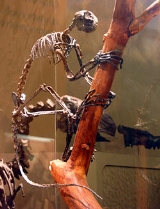
Smilodectes
Encyclopedia
Smilodectes is an extinct genus
of primate
that lived in Wyoming
. It possesses a post-orbital bar and grasping thumbs and toes. Smilodectes has a small cranium size and the foramen magnum was located at the back of the skull, on the occipatal bone.
It appears during the Eocene epoch, and is thought to be related to lemur
s.
primate
from the early Eocene
, some 55 million years ago. S. gracilis was found on the land mass of North America
and based on its dental morphology, S. gracilis was a folivore
.
S. gracilis had a dental formula of and had a relatively short snout
, with rounded frontal bone as compared to other nothactines. This species lacked symphyseal fusion and this species of primate had comparatively reduced olfactory bulbs and a more expanded visual cortex
. This suggests that S. gracilis was a diurnal
species
. S. gracilis had a cranial capacity of 9.5 cc. It is thought that S. gracilis had an average body mass of around 2.1 kilograms. Based upon its postcranial skeleton, S. gracilis was a vertical clinger and leaper.
Genus
In biology, a genus is a low-level taxonomic rank used in the biological classification of living and fossil organisms, which is an example of definition by genus and differentia...
of primate
Primate
A primate is a mammal of the order Primates , which contains prosimians and simians. Primates arose from ancestors that lived in the trees of tropical forests; many primate characteristics represent adaptations to life in this challenging three-dimensional environment...
that lived in Wyoming
Wyoming
Wyoming is a state in the mountain region of the Western United States. The western two thirds of the state is covered mostly with the mountain ranges and rangelands in the foothills of the Eastern Rocky Mountains, while the eastern third of the state is high elevation prairie known as the High...
. It possesses a post-orbital bar and grasping thumbs and toes. Smilodectes has a small cranium size and the foramen magnum was located at the back of the skull, on the occipatal bone.
It appears during the Eocene epoch, and is thought to be related to lemur
Lemur
Lemurs are a clade of strepsirrhine primates endemic to the island of Madagascar. They are named after the lemures of Roman mythology due to the ghostly vocalizations, reflective eyes, and the nocturnal habits of some species...
s.
Named species
There are three named species: Smilodectes gracilis, Smilodectes gingerichi and Smilodectes mcgrewi.Smilodectes gracilis
Smilodectes gracilis was an adapiformesAdapiformes
Adapiformes are an extinct group of primitive primates.The adapiformes radiated throughout much of the northern continental mass, reaching as far south as northern Africa and tropical Asia. The adapiformes existed from the Eocene to the Miocene epoch...
primate
Primate
A primate is a mammal of the order Primates , which contains prosimians and simians. Primates arose from ancestors that lived in the trees of tropical forests; many primate characteristics represent adaptations to life in this challenging three-dimensional environment...
from the early Eocene
Eocene
The Eocene Epoch, lasting from about 56 to 34 million years ago , is a major division of the geologic timescale and the second epoch of the Paleogene Period in the Cenozoic Era. The Eocene spans the time from the end of the Palaeocene Epoch to the beginning of the Oligocene Epoch. The start of the...
, some 55 million years ago. S. gracilis was found on the land mass of North America
North America
North America is a continent wholly within the Northern Hemisphere and almost wholly within the Western Hemisphere. It is also considered a northern subcontinent of the Americas...
and based on its dental morphology, S. gracilis was a folivore
Folivore
In zoology, a folivore is a herbivore that specializes in eating leaves. Mature leaves contain a high proportion of hard-to-digest cellulose, less energy than other types of foods, and often toxic compounds. For this reason folivorous animals tend to have long digestive tracts and slow metabolisms....
.
S. gracilis had a dental formula of and had a relatively short snout
Snout
The snout, or muzzle, is the protruding portion of an animal's face, consisting of its nose, mouth, and jaw.-Terminology:The term "muzzle", used as a noun, can be ambiguous...
, with rounded frontal bone as compared to other nothactines. This species lacked symphyseal fusion and this species of primate had comparatively reduced olfactory bulbs and a more expanded visual cortex
Visual cortex
The visual cortex of the brain is the part of the cerebral cortex responsible for processing visual information. It is located in the occipital lobe, in the back of the brain....
. This suggests that S. gracilis was a diurnal
Diurnal animal
Diurnality is a plant or animal behavior characterized by activity during the day and sleeping at night.-In animals:Animals that are not diurnal might be nocturnal or crepuscular . Many animal species are diurnal, including many mammals, insects, reptiles and birds...
species
Species
In biology, a species is one of the basic units of biological classification and a taxonomic rank. A species is often defined as a group of organisms capable of interbreeding and producing fertile offspring. While in many cases this definition is adequate, more precise or differing measures are...
. S. gracilis had a cranial capacity of 9.5 cc. It is thought that S. gracilis had an average body mass of around 2.1 kilograms. Based upon its postcranial skeleton, S. gracilis was a vertical clinger and leaper.

